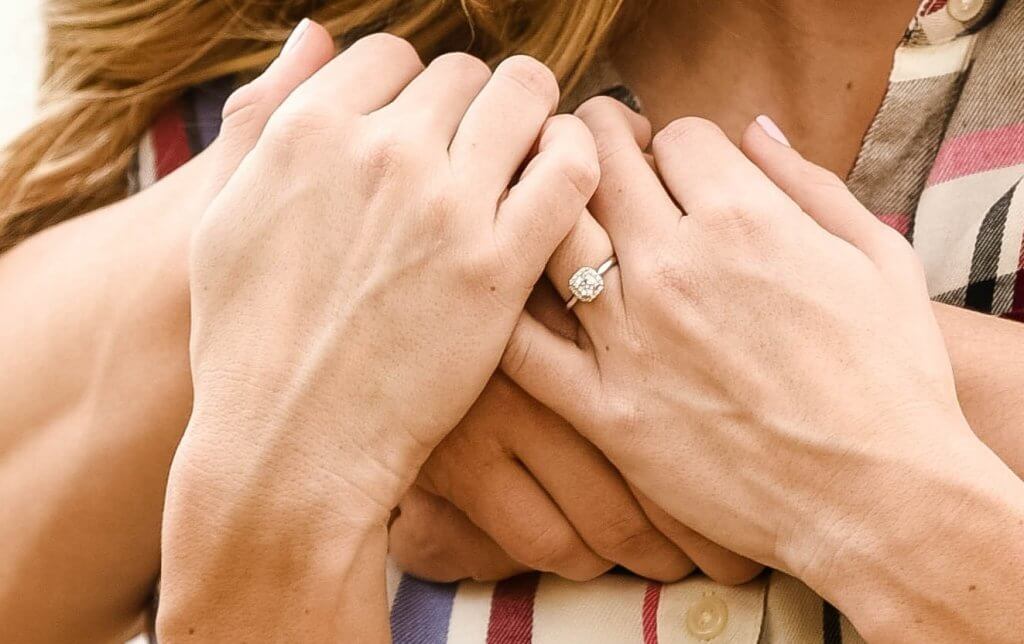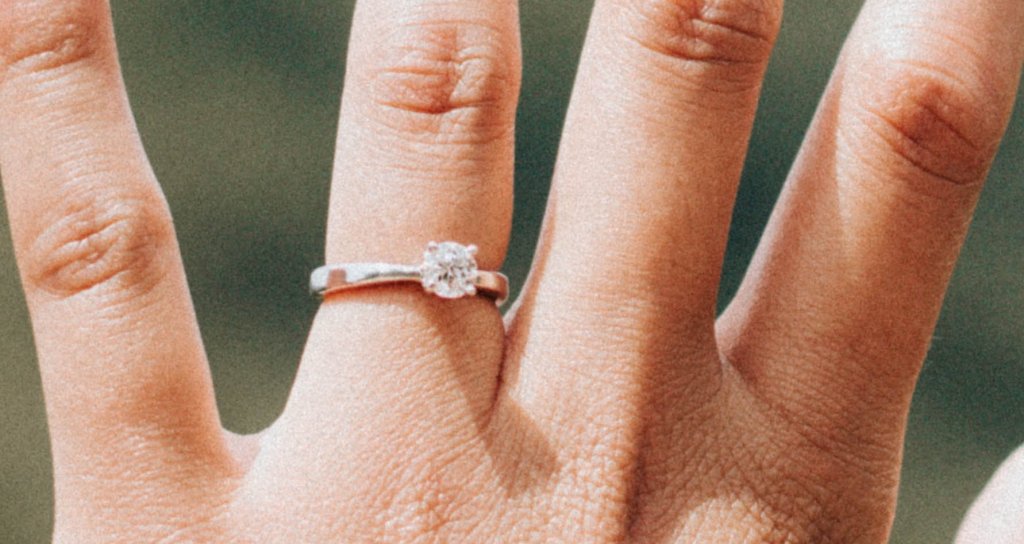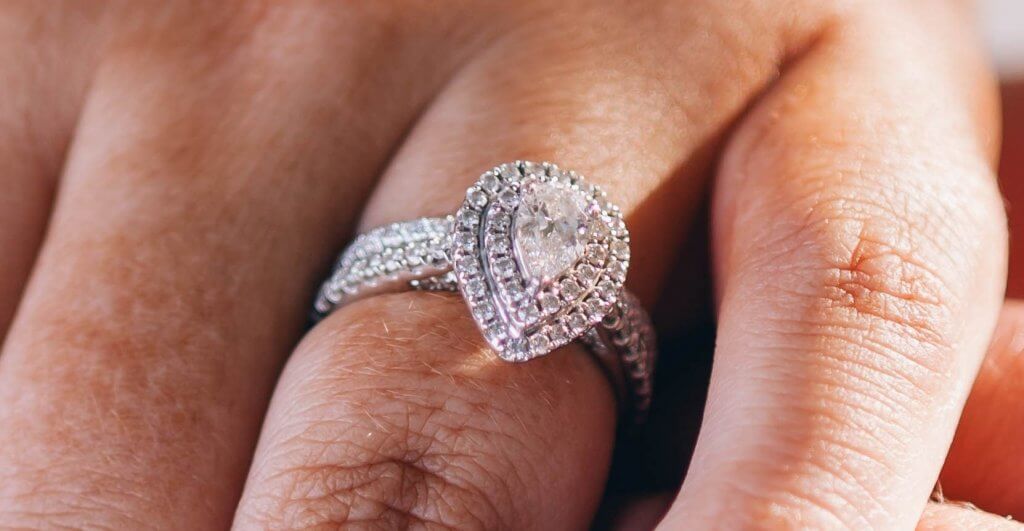Diamond Color vs Clarity | What Matters More?
Key Takeaways
- There’s a lot to get your head around when it comes to the Four Cs, particularly the Clarity and Color of a diamond, which are very open-ended subjects.
- The Color grade refers to how little color is actually present within the diamond. A vague yellow or brown tinge is an undesirable trait, and can ruin an otherwise gorgeous stone.
- The Clarity grade refers to how many inclusions or blemishes may be present within the diamond.
- Under normal light the difference between two Color grades wouldn’t be visible, but that’s not to say the grade doesn’t matter. We never advise our readers go beyond the ‘Near Colorless’ range for that reason.
- The same goes for the Clarity grade. You don’t need to go for the highest possible one, as the differences will be marginal. In fact, you want to go as far from the top grades as you can without winding up with visible inclusions.
- Strike a balance between both features. All that matters is what the eye can see – not what’s visible under magnification.

When you finally start to learn about the four Cs of diamonds, you’ll find that doing so can instantly make the path forward look a little clearer. By getting comfortable with the language surrounding a diamond’s most important characteristics, and learning how to interpret each grading system, you can make a much wiser investment.
However, don’t fall into the trap of thinking it’s plain sailing from there on out. Learning how to balance each of the four Cs – and, of course, how to find a diamond that checks all your boxes – is an art in and of itself. While it would be easy to simply look for a diamond with the highest possible grades in all categories, it’s just not possible – or advisable.
Not only are these diamonds incredibly rare, but a large, internally flawless D color diamond is going to cost far more than you actually need to budget for in order to create the perfect ring. Yes, it would be easier – but, let’s face it, it’s not going to happen.
Instead, you’ve got to continually weigh up your options, compare and contrast two marginally different diamonds, and learn how not to shoot for perfection, until you eventually strike gold. Or, in this case, diamond.
Clarity vs Color – The Key Difference
Our article on the four Cs of diamond quality goes into the key differences between the various in a lot more detail but, in a nutshell:
- Color
A diamond’s color grade refers only to how close to colorless it is – or, alternatively, how much of a yellowish tint developed naturally within the gemstone before it was mined and cut. This grade ranges from D (colorless) to Z, although jewelers will rarely offer diamonds anywhere near that low. Z color diamonds will feature a conspicuous yellow-brown color, not to be confused with the separate grading system used for fancy colored diamonds.
- Clarity
A diamond’s clarity grade, on the other hand, refers to how many (or few) inclusions and blemishes it features. Many of these inclusions are natural, and develop over billions of years a little like birth marks. For the most part, they are also buried deep within the internal structure of the diamond. Some surface blemishes, however, can be natural, or caused by the handling and cutting process after they are taken from the earth.
In both instances, the most sought-after diamonds are of course those with no discoloration, inclusions, or blemishes. Perfection comes highly prized among collectors, although the natural charm of minor inclusions is also admired by many diamond wearers around the world.
- Color
- Does Diamond Color Really Matter?
- What is the Lowest Color Diamond You Should Buy?
- How Can I Make My Diamond Look Whiter?
- Clarity
- Is Diamond Clarity Really Important?
- What is the Lowest Clarity Diamond You Should Buy?
- Can You Get Rid of Inclusions in Diamonds?
- Clarity vs Color
- Does Color or Clarity Make a Diamond Sparkle?
- Is Color or Clarity More Expensive?
- So, What Clarity and Color is Best for Diamonds?
- Our Summary
Color
Out of all the four Cs, this one is probably the first one to cause much confusion in first-time shoppers, since, unless you’re going against the grain and picking a fancy colored diamond, there doesn’t seem to be much use for the color grading system, right? Think again…
Does Diamond Color Really Matter?
Yes, but only to a certain extent. You don’t have to pick a D color diamond to make the most out of your budget, since the difference will be far too subtle to matter – particularly when it’s worn on the finger as part of a stunning ring. Under normal lighting, the difference between two good color grades won’t be visible.
While diamond shopping would definitely be much easier if we could rule-out one of the four Cs entirely and give ourselves one less thing to worry about when we look over those GIA Reports, it would be a bad idea to head out there without paying any attention at all to the color grade.
On the one hand, you could end up paying a high price a superior grade that barely looks any different to a lower, more affordable grade – meaning you’ll have less to spend on more conspicuous features, such as cut and carat weight. For instance, it’s pretty unlikely you’ll notice any difference between this D color Round Diamond and this G Color Round Diamond – and especially when they’re both worn against the skin – although there will be a significant price difference between the two.
On the other hand, you could end up with a diamond that features a visible tint that detracts from the ‘wow factor’ you’re looking for and, in a word, looks a little antiquated.
So, yes, diamond color matters, but D colored diamonds definitely don’t need to represent the aim of the game when you go to the jewelry store. Provided you don’t dip below a certain level, you’ll not need to worry too much.

What is the Lowest Color Diamond You Should Buy?
We don’t recommend going any lower than a J color diamond. A K color or lower will feature too much unwanted color, and will disrupt the natural beauty that we all want to find within our chosen diamond. There is a definitely a reason why these diamonds are significantly lower in value.
But, as we mentioned above, some cuts do show their color more than others. For instance, a J color Cushion or Pear cut diamond will likely show more of a tint than a round cut diamond so, in this case, its vital that you make the time to see them in person before committing. A photograph and a video are definitely useful tools when you’re browsing, but you can’t put your money on the line when it comes to something this important.
Similarly, the color of the setting can also help to complement or mask any unwanted yellow coloring in your diamond. A diamond with a lower color grade can look stunning against the much warmer hues of yellow or rose gold, which can off-set any slight yellowing. On the other hand, a near-colorless diamond will dazzle against a bright platinum band.
Clarity
Chances are, you’ve already heard about eye clean diamonds but, if you’re still pretty early on in your diamond-hunting process, the term probably still goes over your head somewhat. After all, it’s a little more subjective than simply reading through a GIA Grading Report and making your decision based off that.
Like anything, though, you’ve just got to find the right place to start…
Is Diamond Clarity Really Important?
Yes but, as with diamond color, you don’t need to shoot for the very highest grades in order to find a stunning, eye clean diamond. This is where you really need to be led by eye cleanliness.
We can rule FL (flawless) diamonds out of the equation entirely. Not only are they incredibly rare, but they’re far too expensive to prove worthwhile to the overwhelming majority of people looking to purchase a diamond for an engagement ring.
Why? Because, for a diamond to be flawless, it needs to have no blemishes visible at up to 10x magnification. Considering the human eye can’t appreciate perfection at that level of magnification, there really is no use in paying for it unless you’re an avid diamond collector.
For that reason, the same thing holds true for IF or internally flawless diamonds. They’re incredible, yes, but they’re not worth it unless you’ve got an unlimited budget to work with.
Like the color grades, many of the higher grades will be both more affordable and, to the human eye, appear unflawed.
What is the Lowest Clarity Diamond You Should Buy?
Always aim for eye cleanliness, which usually falls around a grade of VS1.
As mentioned, the difference between a VS1 diamond and a VVS diamond is going to be visible only under magnification, and both with look pretty much identical (provided they’re of similar cuts, colors, and carat weights) when you look and hold them in person.
For that reason, unless you’re seduced by the idea that your VVS diamond is verging on perfect, there really is no point investing an additional lump sum into this clarity grade.

Clarity vs Color
So, now that we’ve covered the basics, how are you supposed to think about one alongside the other – and, for anyone with any sort of a budget to follow, which one is more important? While we would always recommend that you focus on finding that elusive balance between clarity and color, they’re not exactly ‘created equal’…
Does Color or Clarity Make a Diamond Sparkle?
Clarity has more impact on a diamond’s brilliance and fire than color, although its cut is by far the most important factor when it comes to maximizing sparkle.
One of the main reasons why internally flawless and very, very slightly included diamonds are so popular is because visible inclusions can interrupt the diamond’s light performance, since noticeable inclusions will prevent light from travelling so ‘cleanly’ through the center of the diamond.
But, while a large cloud or feather (two common types of inclusion) will dull an otherwise magnificent and mesmeric dance of light through the diamond, that’s not to say that a VS diamond is a poor purchase compared with a VVS2 diamond. Provided it is eye clean, then a well-cut diamond will sparkle beautifully.
Understanding which diamond cut sparkles the most is far more important than agonizing over two eye-clean grades for clarity – or, of course, color.
Is Color or Clarity More Expensive?
Both factors have a pretty significant impact on the diamond’s value, alongside cut and carat weight. Any grade of color or clarity that appears eye clean will come at a premium.
Look at it this way, you’re (hopefully) never going to shop around for a diamond with a very, very high color grade and a very low clarity grade – or vice versa – so it’s much more helpful to know whether you should be aiming for with regards to both, rather than how each one value on its own.
When it comes to color, an E or F color diamond is considered colorless, while G, H, I and J color diamonds are ‘near colorless’, as the yellow tint is barely noticeable. In general, you should stick within this parameter – although some cuts, such as the Cushion, and certain settings will necessitate a higher color grade.
When it comes to clarity, the same basic principle holds true: the top grades, all the way down to around about VS1, will appear eye clean.
So, What Clarity and Color is Best for Diamonds?
If you’re on a budget, start by looking at J color VS1 diamonds. That way, you can ensure that you don’t dip below a certain quality, and that eye cleanliness will still be attainable.
Many people presume that ‘making sacrifices’ means settling for a poorer quality diamond. This is definitely not true – it simply means realizing that perfection is costly, and not quite as great a choice as it might sound at first.
Before you jump to any conclusions, however, it’s definitely worth using our Diamond Search Engine to filter down results until you hit upon something that speaks to you. Depending on your budget, you might then start increasing your specifications – whether for color or clarity or, of course, cut and carat weight – until you find your ‘ideal balance’.
At that point, we can then put you in touch with a local jeweler where you can view it in person. This is a vital step, because all diamonds have their own unique character; even if you’ve struck a good balance between the four Cs, that’s not to say the first diamond you hit upon will be the perfect one for you.
Our Summary: What is Better Clarity or Color in a Diamond?
In our opinion, striking a balance between both features is far, far more important than prioritizing one over the other. A diamond that has been graded as internally flawless, but which features a distinctly yellow tint, will look less impressive than an eye clean, near-colorless diamond.
Color does give slightly more scope than clarity. For eye cleanliness, you ideally want to aim for around VS1 or VS2, whereas near-colorless diamonds include grades G, H, I, and J. What’s more, its easier to complement a very slightly discolored diamond with clever settings choices than it is to hide inclusions, particularly if they are scattered across the center of the diamond.
Nevertheless, we would never recommend that anyone looking for a diamond to sit in the center of their engagement ring focus all their attention on one aspect of the ring, and only pay lip service to another.
Remember that, while a VVS E or F color diamond is ideal, you still need to take into account the diamond’s cut and carat weight – both of which have a more significant impact on the first impression your diamond will make.
Don’t feel ‘ground down’ by these two separate factors. The fact that you don’t need to aim for perfection, and that both clarity and color offer plenty of leeway for those on tighter budgets, mean that the process of finding the right diamond is actually made easier. Once you know where the ‘comfortable’ middle ground is between perfection and visible imperfection, it becomes much, much easier to begin narrowing your choices down, and finally settling on a diamond worthy of your future bride.

Sep 2, 2021 By Willyou.net
Choosing F Color Diamonds: A Complete Guide

Sep 9, 2021 By Willyou.net
Everything You Need to Know About E Color Diamonds








